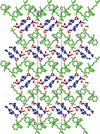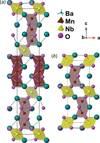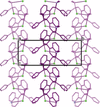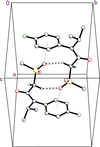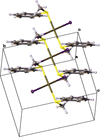issue contents
May 2023 issue

Cover illustration: In 2004, the antidepressant drug (S)-duloxetine hydrochloride came onto the market as the first chirally pure serotonin-norepinephrine reuptake inhibitor. This report describes the molecular and crystal structure of hydrochloride salt of racemic duloxetine and compares it to the (S)-enantiomer. A Cambridge Structural Database search for common antidepressants and related molecules provides relevant information for the design of duloxetine co-crystals with improved biological efficacy. See: Bhadbhade, Gao, Rich & Marjo [Acta Cryst. (2023). E78, 488–493].
modern approaches and tools for teaching crystallography
Recent years have seen a flurry of research activity in the field of electron diffraction. The introduction of the electron diffractometer, designed to be fully dedicated to its task of providing the best data from electron-diffraction experiments, will be a crucial factor for the continued growth and success of this technology.
research communications
Download citation


Download citation


The crystal structures and Hirshfeld surface analyses of three salts of 1-(4-nitrophenyl)piperazine with 2-chlorobenzoic acid, 2-bromobenzoic acid and 2-iodobenzoic acid are reported.
Download citation


Download citation


Two crystallographically unique 4-fluoro-1H-pyrazole moieties linked by an N—H⋯N hydrogen bond are found in the asymmetric unit. Unlike the trimeric supramolecular motifs found in the structures of the chloro and bromo analogues, 4-fluoro-1H-pyrazole forms one-dimensional chains by intermolecular hydrogen bonding in the crystal.
CCDC reference: 2253642
Download citation


Download citation


A new copper(II) coordination compound [Cu2(LEt)2(OAc)2(dmf)2], where HLEt = 3-(2-pyridyl)-5-ethyl-1,2,4-triazole, was synthesized and structurally characterized by single-crystal X-ray diffraction.
CCDC reference: 2253664
Download citation


Download citation


In the title compound, molecules are linked together by O—H⋯O and C—H⋯O hydrogen bonds, forming zigzag chains that are parallel to the (001) plane and run along the b-axis direction. van der Waals interactions between these chains along the a and c axes maintain the molecular packing.
CCDC reference: 2254247
Download citation


Download citation


In the crystal structure of the title compound, the C=N—C angle is wide [125.28 (8)°]. The benzothiazole and chromene ring systems are almost coplanar and lie parallel to (1![[\overline{1}]](/e/issues/2023/05/00/yz2032/teximages/yz2032fi1.svg) 0); the toluene ring system is rotated by ca 40° out of the chromene plane.
0); the toluene ring system is rotated by ca 40° out of the chromene plane.
CCDC reference: 2252955
Download citation


Download citation


The various intermolecular interactions, such as N—H⋯O, C—H⋯N and C—H⋯O, were investigated using Hirshfeld surface analysis and the three-dimensional interaction energies were calculated.
CCDC reference: 2202315
Download citation


Download citation


The syntheses and low-temperature crystal structures of four organic salts of amitriptynol, a common impurity in the anti-depressant drug amitriptyline, are described.
Download citation


Download citation


The crystal structures of a dihydrofurylsilane and a dihydrofurylgermane are reported. Hirshfeld surface analyses were performed to investigate the intermolecular interactions.
CCDC reference: 2254180
Download citation


Download citation


In the title mononuclear nickel(II) complex, the nickel(II) atom is bischelated by a carbohydrazinate ligand bearing unsaturated alkyl chains.
CCDC reference: 2232075
Download citation


Download citation


Nearly complete conversion to a Ba3Nb0.75Mn2.25O9-6H structure was observed following thermochemical reduction of the parent Ba4NbMn3O12-12R material. The Ba3Nb0.75Mn2.25O9-6H structure represents a hexagonal perovskite that displays substitution of Mn onto Nb sites in order to satisfy the 3:1 Mn:Nb ratio within the 6H structural motif.
Download citation


Download citation


In the crystal of the title compound, adjacent molecules are connected by intermolecular C—H⋯O hydrogen bonds, forming a three-dimensional network.
CCDC reference: 2255517
Download citation


Download citation


The crystal structure of bis(μ-4-tert-butoxy-4-oxobut-2-en-2-olato)bis[(4-tert-butoxy-4-oxobut-2-en-2-olato)ethanolzinc(II)] is reported and discussed.
CCDC reference: 2255847
Download citation


Download citation


In the crystal structure of the title compound, discrete complexes are observed, in which the Ni cations are octahedrally coordinated by two terminal N-bonded selenocyanate anions and four pyridine coligands. Weak C—H⋯Se interactions occur in the extended structure.
CCDC reference: 2257160
Download citation


Download citation


The structure of the hydrochloride salt of the anti-depressant drug duloxetine in its racemic form shows differences in the side chain conformation and molecular packing compared to its chirally pure crystal form. A Cambridge Database search of anti-depressant structures shows a high correlation between the side-chain conformation and the packing of molecules, a feature of interest from a crystal engineering perspective.
CCDC reference: 2033424
Download citation


Download citation


In the crystal, molecules are linked by intermolecular N—H⋯O and N—H⋯N hydrogen bonds into ribbons parallel to (022) along the a axis. These ribbons are connected by N—H⋯O, N—H⋯N hydrogen bonds and van der Waals interactions.
CCDC reference: 2255359
Download citation


Download citation


In the crystal, C—H⋯O hydrogen bonds link adjacent molecules in the three-dimensional network, while π–π stacking interactions, with centroid–centroid distances of 3.8745 (9) Å, propagate into chains parallel to the a axis.
CCDC reference: 2257159
Download citation


Download citation


The title molecule is almost planar, with an intramolecular S⋯O=C contact. The packing is a layer structure with dimeric units connected by a C—H⋯O=C hydrogen bond.
CCDC reference: 2256779
Download citation


Download citation


In the crystal struture of the title compound, Na+ cations form a chain parallel to [010] through bonding to common water molecules.
CCDC reference: 2257827
Download citation


Download citation


In the title compound, which is related to the herbicide flufenacet, the amide group and fluorobenzene ring are almost perpendicular. A short O⋯π contact is observed in the crystal.
CCDC reference: 2258160
Download citation


Download citation


The title complex represents a further example of a square-planar PtII–dithioether complex. It crystallizes in the monoclinic space group P21/c. Additional Hirshfeld analyses indicate a C—H⋯π interaction along the [010] axis to be the most important packing factor.
CCDC reference: 2258409

 journal menu
journal menu


















